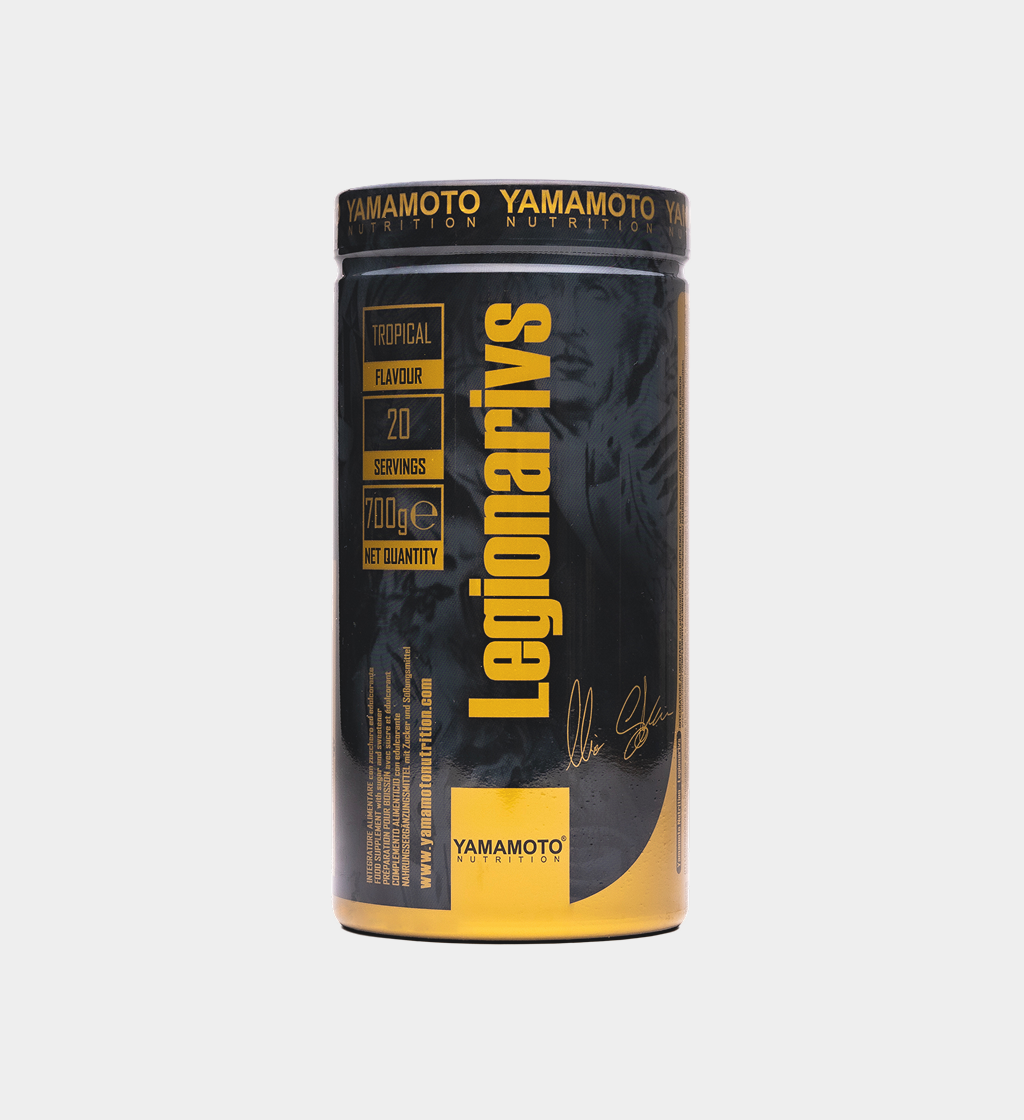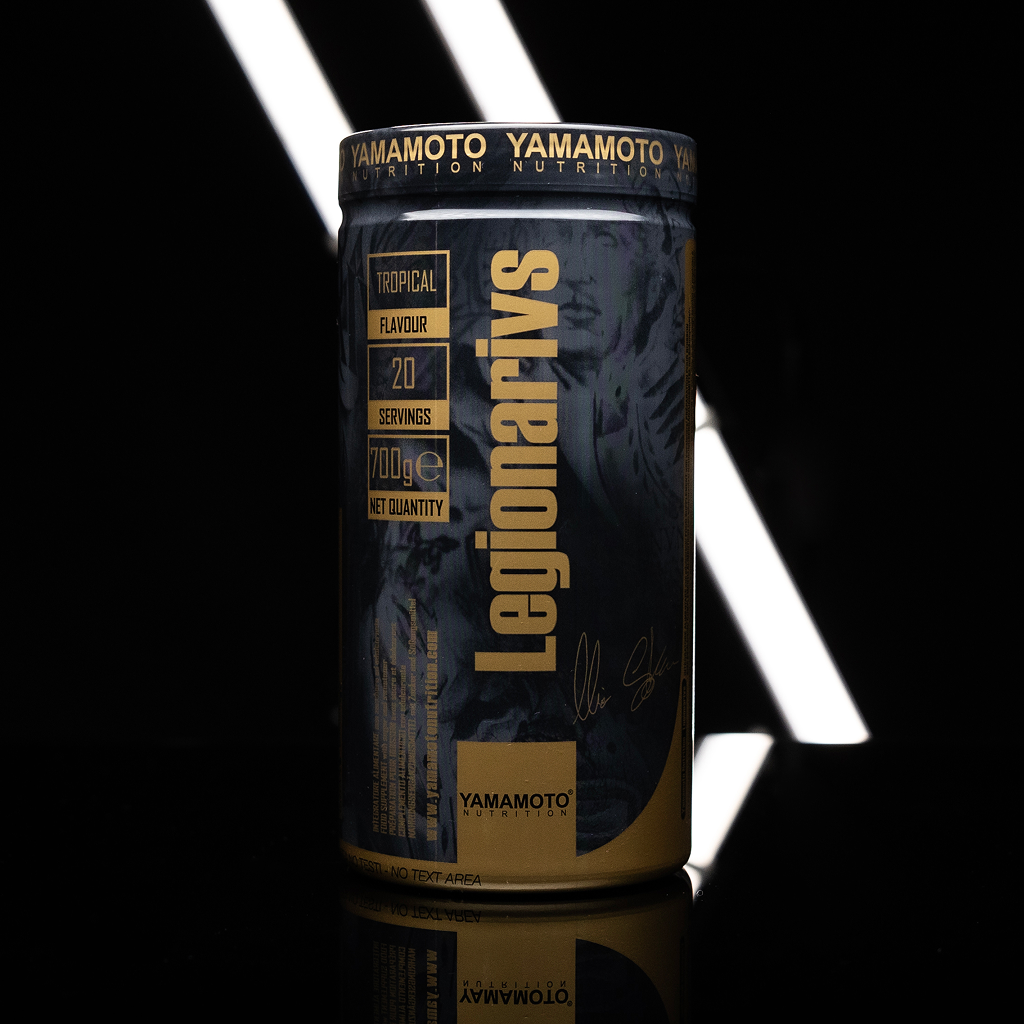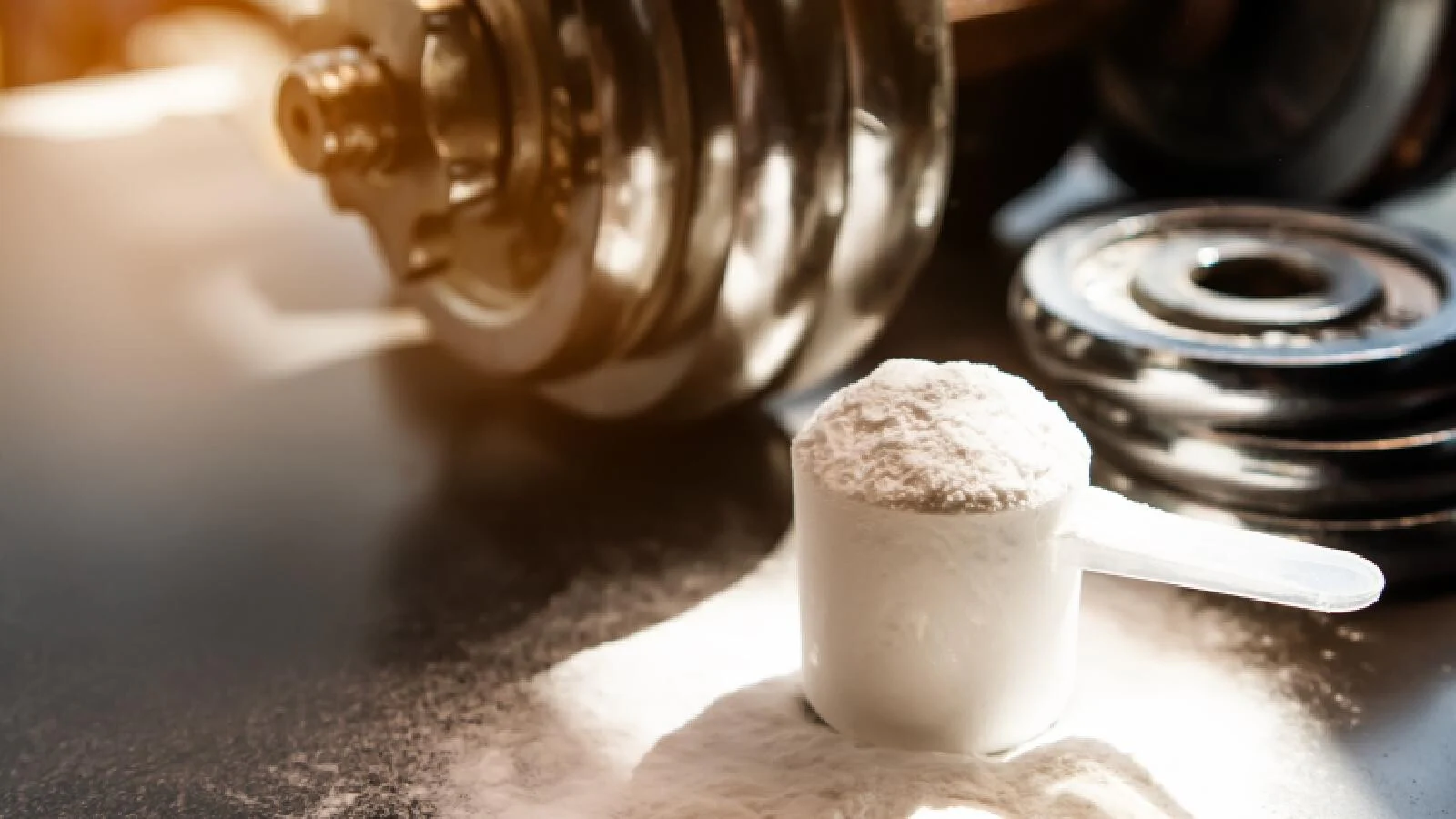Legionarius
700 grams
128 AED
- Isomaltulose (Palatinose®) provides long-lasting energy with low glycemic impact
- Includes BCAAs (2:1:1) from plant fermentation for muscle support and endurance
- Enriched with coconut water and electrolytes (magnesium, potassium, chloride) in citrate form
- With vitamins B6 and B12 to reduce fatigue and support energy metabolism
- Ideal for combat sports, CrossFit, triathlon, cycling, and endurance training
- Designed to support hydration, mental focus, and sustained physical performance
- Developed in collaboration with MMA champion Alessio Sakara
- Produced with certified raw materials and tested for gluten and lactose
amamoto® Nutrition Legionarius is a food supplement made with isomaltulose Palatinose® and branched-chain amino acids (BCAAs) in a 2:1:1 ratio derived from plant fermentation, enriched with coconut water and electrolytes in citrate form.
The product is enriched with magnesium and potassium, which contribute to normal muscle function, and with vitamins B6 and B12, which—alongside magnesium—contribute to normal energy metabolism and help reduce tiredness and fatigue.
To maintain prolonged performance without physical or mental dips, athletes need constant energy support, while avoiding dehydration as much as possible. As always, Yamamoto® Nutrition’s mission is to develop highly effective products made from excellent raw materials, designed to meet the needs of athletes of all levels.
Thanks to close collaboration with professional athletes, continuous feedback, and the partnership between international MMA champion Alessio Sakara and Dr. Gabriele Trapani (Director of Research and Development at Yamamoto® Nutrition), we created Legionarius—a supplement designed to support the intense and prolonged training sessionstypical of fighters and athletes in combat sports, CrossFit, triathlon, marathon, cycling, and bodybuilding.
A professional athlete is a “holistic athlete”, heavily engaged in both aerobic and anaerobic effort, requiring a combination of responsiveness and endurance. He or she must sustain performance for long periods without energy crashes, mental fatigue, or digestive discomfort—and must recover as quickly as possible.
Legionarius is a Special Edition, developed based on the specific needs reported by a top-level athlete like Alessio Sakara. Our R&D department focused on the most critical issues that may arise during training or competition to create a product designed “by athletes, for athletes.”
Legionarius is a blend of ingredients to be consumed during training (mixed into a bottle or water flask), delivering a gradual wave of energy to support the muscles under stress, thanks to:
- Isomaltulose Palatinose® – a certified efficient carbohydrate
- Highly soluble BCAAs from plant fermentation
- Electrolytes in citrate form
- Coconut water
To achieve optimal energy performance during such a crucial phase, the athlete must consume high-quality, well-tolerated fuel.
Isomaltulose Palatinose®
Isomaltulose (Palatinose®) is a low-glycemic disaccharide sugar, composed of glucose and fructose. Naturally found in small amounts in honey and cane sugar, it has a sweetening power of about 45–50% compared to sucrose (table sugar). Recently, it has gained popularity in sports drinks due to its properties.
With a gradual absorption and release in the bloodstream, isomaltulose offers a moderate glycemic curve without spikes or sudden drops like those seen with glucose or maltodextrins. It is therefore a slow-release energy source that can sustain the body even during extended training sessions.
Due to its structure, it does not raise blood sugar or insulin levels excessively and does not cause gastrointestinal discomfort, such as fermentation, nausea, or osmotic diarrhea. It delivers stable energy and hydration thanks to its low osmolarity.
Branched-Chain Amino Acids (BCAAs)
BCAAs are widely appreciated by both strength and endurance athletes. They include three essential amino acids:
- Leucine
- Valine
- Isoleucine
These are essential nutrients the body cannot produce and must be obtained through diet. BCAAs are absorbed in the intestines and enter the bloodstream as free amino acids, bypassing the liver and being metabolized directly in muscle tissue.
Because they make up a large proportion of the essential amino acids in muscle, BCAAs help prevent muscle breakdown (catabolism) during training and are beneficial for both power and endurance sports, supporting muscles and delaying fatigue.
During prolonged, intense physical activity, muscle glycogen may become depleted, triggering an energy emergency. The body then begins to oxidize BCAAs from muscle proteins, which can compromise performance and recovery.
Mineral Salts, Electrolytes, Coconut Water
In addition to blood sugar balance, hydration is a key factor for athletes. Excessive fluid loss can severely impair performance and health. Losing more than 2% of body weight in fluids can significantly impact physiological function, causing:
- Increased physical and mental fatigue
- Higher body temperature
- Elevated heart rate due to decreased blood volume
- Greater glycogen consumption
- Altered metabolism
- Gastrointestinal issues
- Headaches
- Cognitive disturbances
- In extreme cases, collapse
Maintaining a good electrolyte balance before, during, and after exercise is crucial. Legionarius helps prevent dehydration thanks to a precise blend of:
- Electrolytes
- Magnesium
- Potassium
- Chloride
It also includes the natural rehydrating power of coconut water, rich in micronutrients that help prevent cramps caused by intense sweating or heat exposure.
Certified Quality Raw Materials
Yamamoto® Nutrition uses only certified and accredited raw materials. The ingredients are Grade A certified for the BRC Global Standard for Food Safety Issue 8 and are produced in Informed-Sport registered facilities.
Upon arrival in Italy, each batch undergoes rigorous quality testing before being used to produce the finished product, following strict manufacturing standards in Italian factories.
All products are also tested for potential allergens such as gluten and lactose.
Scientific References
Siddiqua, I.R; Furhala, B. 1967. Isolation and characterization of oligosaccharides from honey.
Part I Disaccharides. J Apicult Res 6:139-145. Cited In: Irwin & Sträter.
Food Standard Agency UK. Dossier for application for approval of Isomaltulose according to Novel Food EEC Regulation.
Available on www.food.gov.uk Regulation (EC) No 258/97 of the European Parliament and of the Council of 27th January 1997 concerning novel foods and novel food ingredients.
NutriScience. 2002. The Effect of Dextrose and Isomaltulose Ingestion on Serum Glucose and Insulin Levels in Healthy Volunteers.
NutriScience Report 72.01.0003.
NutriScience. 2003. Study on the Intestinal Absorption of Isomaltulose, Trehalose, and Soy-Isoflavones. Report on Isomaltulose.
NutriScience Report 72.01.0010/B.
Achten, J.; Jentjens, R.; Jeukendrup, A. 2003. Exogenous Oxidation of Sucrose and Isomaltulose Ingested During Moderate Intensity Exercise. Internal Report Cerestar. 18 July 2003.
Kawai, K.; Okuda, Y.; Yamashita, K. 1985. Changes in blood glucose and insulin after an oral palatinose (isomaltulose) administration in normal subjects. Endocrinol Jpn 32(6):933-936.
Kawai, K.; Okuda, Y.; Chiba, Y.; Yamashita, K. 1986. Palatinose (isomaltulose) as a potential parenteral nutrient: its metabolic effects and fate after oral and intravenous administration to dogs. J Nutr Sci Vitaminol 32:297-306.
Kawai, K.; Yoshikawa, H.; Murayama, Y.; Okuda, Y.; Yamashita, K. 1989. Usefulness of palatinose (isomaltulose) as a caloric sweetener for diabetic patients. Horm Metab Res 21:338-340.
Hespel, P.; Van den Eede, E.; Ramaekers, M.; Muls, E.; Vansant, G. 2003. Effects of Isomaltulose Intake on Blood Glucose and Insulin Concentration at Rest and During Exercise in Patients With Insulin Resistance: Comparison With Fructose. Final Report. 10 July 2003.
Liao, Z.-H.; Li, Y.-B.; Yao, B.; Fan, H.-D.; Hu, G.-L.; Weng, J.-P. 2001. The effects of isomaltulose on blood glucose and lipids for diabetic subjects. Diabetes 50(Suppl. 2):A366 [Abstract No.1530-P].
Irwin, W.E.; Sträter, P.J. 1991. Isomaltulose. In: O’Brien Nabors, L.; Gelardi, R.C. (Eds.). Alternative Sweeteners (2nd Rev.Expanded Ed.). Marcel Dekker; New York, pp. 299- 307.
Jonker, D.; Lina, B.A.R.; Kozianowski, G. 2002. 13-week oral toxicity study with isomaltulose (Palatinose®) in rats.
Food Chem Toxicol 40(10):1383-1389.
Kashimura, J.; Hara, T. and Nakajinma, Y. 1993. Effects of isomaltulose-based oligomers on the human intestinal environment.
Nihon Eiyo Shokuryo Gakkaishi 46(2):117-122.
MacDonald, I.; Daniel, J.W. 1983. The bioavailability of isomaltulose in man and rat. Nutr Rep Int 28(5):1083-1090.
Sasaki, N.; Topitsoglou, V.; Takazoe, I.; Frostell, G. 1985.
Cariogenicity of isomaltulose (palatinose), sucrose and mixture of these sugars in rats infected with streptococcus mutans E-49.
Swed Dent J 9(4):149-155.
SCF. 1984. Report of the Scientific Committee for Food on Sweeteners (Opinion expressed in 1984), 16th Series, 1985. http://www.europa.eu.int/comm/food/fs/sc/scf/reports/scf_reports_16.pdf
SCF. 1997. Minutes of the 107th Meeting of the Scientific Committee for Food (SCF). 12-13 June 1997. http://europa.eu.int/comm/food/fs/sc/oldcomm7/out13_en.html
Takazoe, I. 1985. New trends on sweeteners in Japan. Int Dent J 35(2):58-65.
Topitsoglou, V.; Sasaki, N.; Takazoe, I.; Frostell, G. 1984. Effect of frequent rinses with isomaltulose (Palatinose®) solution on acid production in human dental plaque. Caries Res 18(1):47-51. Cited In: Birkhed et al., 1987
U.S. FDA. 1997. Secondary Direct Food Additives Permitted In Food For Human Consumption; Proposed rule (21 CFR Part 173.25). Fed Regist (US) 62(74).
“Carbohydrates, branched-chain amino acids, and endurance: the central fatigue hypothesis”, Davis, J.M.; Int. J. Sports Nutr. Suppl. 5:S29-S38, 1995.
a b Shimomura et al. Exercise promotes BCAA catabolism: effects of BCAA supplementation on skeletal muscle during exercise. J Nutr. 2004 Jun;134(6 Suppl):1583S-1587S.
a b Harper et al. Branched-chain amino acid metabolism. Annu Rev Nutr. 1984;4:409-54.
Rennie MJ. Exercise- and nutrient-controlled mechanisms involved in maintenance of the musculoskeletal mass.
Biochem Soc Trans. 2007 Nov;35(Pt 5):1302-5.
a b c Wagenmakers et al. Carbohydrate supplementation, glycogen depletion, and amino acid metabolism during exercise. Am J Physiol. 1991 Jun;260(6 Pt 1):E883-90.
MacLean et al. Stimulation of muscle ammonia production during exercise following branched-chain amino acid supplementation in humans. J Physiol. 1996 Jun 15;493 ( Pt 3):909-22.
J Exerc Nutrition Biochem. 2013 Dec; 17(4): 169–180. Published online 2013 Nov 28. doi: 10.5717/jenb.2013.17.4.169
PMCID: PMC4241904
PMID: 25566428
“Effect of BCAA intake during endurance exercises on fatigue substances, muscle damage substances, and energy metabolism substances”
Dong-Hee Kim,1 Seok-Hwan Kim,1,* Woo-Seok Jeong,1 and Ha-Yan Lee2
“Dehydration and rehydration in competative sport”
R. J. Maughan S. M. ShirreffsFirst published: 04 October 2010 https://doi.org/10.1111/j.1600-0838.2010.01207.x Citations: 57
Corresponding author: R. J. Maughan, School of Sport, Exercise and Health Sciences, Loughborough University, Loughborough, Leicestershire LE11 3TU, UK. Tel: +441 509 226 329, E‐mail: r.maughan@lboro.ac.uk
Effect of Hypohydration on Muscle Endurance, Strength, Anaerobic Power and Capacity and Vertical Jumping Ability: A Meta-Analysis
Félix-Antoine Savoie1, Robert W Kenefick, Brett R Ely, Samuel N Cheuvront, Eric D B Goulet
Sport Meds. 2015 Aug;45(8):1207-27.doi: 10.1007/s40279-015-0349-0.
“Coconut water uses, composition and properties: a review”.
Alexia Prades (a1), Manuel Dornier (a1) (a2), Nafissatou Diop (a3) and Jean-Pierre Pain (a4) DOI: https://doi.org/10.1051/fruits/2012002 Published online by Cambridge University Press: 07 March 201
“Rehydration After Exercise With Fresh Young Coconut Water, Carbohydrate-Electrolyte Beverage and Plain Water”.
Mohamed Saat1, Rabindarjeet Singh, Roland Gamini Sirisinghe, Mohd Nawawi
J Physiol Anthropol Appl Human Science. 2002 Mar;21(2):93-104. doi: 10.2114/jpa.21.93.
Directions: dissolve the contents of 4 heaped measuring spoons (36 g) in 250 ml of water, mix well until the powder is completely dissolved and take once a day.
Warnings: Do not exceed the recommended daily dose. Keep out of reach of children under 3 years of age. Food supplements are not intended as a substitute for a varied and balanced diet and a healthy lifestyle. Do not use during pregnancy and in children, or in any case for prolonged periods, without consulting a doctor.
Allergen declaration: On the basis of the raw material data sheets, the product does not contain and is not composed of substances causing allergies or intolerances listed in Annex II of EU Reg. 1169/2011.
Anti-doping declaration: No substances on the WADA 2018 list are used as raw materials in the products and none of these substances are present as raw materials in our production plant. No tests are performed to find such substances in the finished product.
Storage instructions: Store in a cool, dry place, away from direct sunlight and localized heat sources. The minimum shelf life refers to the product correctly stored, in intact packaging. Do not disperse in the environment after use.
You must be logged in to post a review.




Reviews
There are no reviews yet.